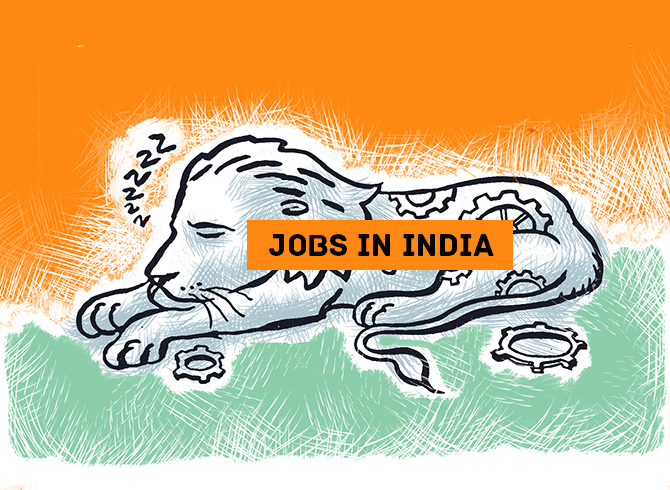 | « Back to article | Print this article |
While the country's unemployment rate is falling, the quality of employment seems to have taken a hit.

The pace of formalisation slowed in the five months of the current financial year (April-August) with more than half a million fewer formal jobs created in the period compared to the same period last year, according to data from the Employees’ Provident Fund Organisation (EPFO).
The payroll data showed that cumulatively 4.92 million new subscribers joined the social security organisation between April-August this year, compared to 5.51 million subscribers in the same period in the previous year, reflecting a 10.7 per cent decline in the number of new payrolls created.
Similarly, the number of young subscribers belonging to the 18-28 age group declined by 9.9 per cent to 3.3 million this year from 3.64 million in the corresponding period last year.
This is crucial because subscribers in this age group are usually first-timers in the labour market, thus reflecting its robustness.
Besides, the number of women subscribers also declined by 10.9 per cent to 1.30 million from 1.46 million last year.
This data is crucial as only the formal workforce enjoys social security benefits and is protected by labour laws.
Rituparna Chakraborty, co-founder of TeamLease Services, said as the firms try to rationalise their workforce, and battle declining revenues and muted demand, hirings in the technology and knowledge sector have been muted this year.
This sector forms a bulk of the formal workforce.

Santosh Mehrotra, a visiting professor at the University of Bath, noted that the labour markets are yet to recover as the pace of formal job creation is quite low and not keeping pace with the rising labour force, leading to an increase in self-employment or engaging in agriculture, particularly for the young and women.
Recently, the annual periodic labour force survey (PLFS) released by the National Statistical Office (NSO) showed that the unemployment rate had dropped to a six-year low of 3.2 per cent in the July-June 2022-23 period from 4.1 per cent in the July-June 2021-22 period.
Similarly, the labour force participation rate had also increased to 57.9 per cent from 55.2 per cent in the corresponding period.
“The recent PLFS data shows an increase in the share of people engaged in agriculture and a fall in the people engaged in manufacturing,” Mehrotra added.
He also said that the decline in formal employment and the corresponding increase in labour force participation shows that more people are joining the labour markets and the economy isn't able to generate enough decent jobs for them.
The PLFS survey has shown that the share of people engaged in agriculture has increased sharply to 45.8 per cent in the 2022-23 period from 45.5 per cent in the 2021-22 period while the share of people engaged in manufacturing has gone down to 11.4 per cent from 11.6 per cent in the same period.
Meanwhile, labour economist KR Shyam Sundar said that the EPFO data does not reflect employment generation, and the subscribers are only a minuscule proportion of the labour force in the country.
“EPFO data only shows the extent of formalisation of the workforce, which in turn means as many people will be getting social security benefits.
"If there is a slowdown (in this) as well, that is a matter of concern,” Sundar added.